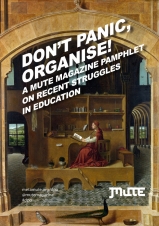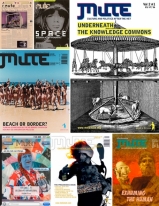Enjoy Your System!
A spectre is haunting the European art system : the spectre of Openness! Marina Vishmidt inspects the freshly objectified remains of ‘Process Art’ exhibited as Open Systems at Tate Modern
'Everything is forgotten, everything is possible, everything is,"great"'Jeff Wall, Dan Graham's Kammerspiel(1)
Until the 18th of September, there is an exhibition of the blockbuster type to be visited at Tate Modern which is called Open Systems: Rethinking Art c.1970. The exhibition showcases a wild, woolly, and professedly heterogeneous array of international responses to the crisis of the autonomous art object over a time period roughly demarcated as the beginning of the 1960s to the mid-late 1970s. Roughly demarcated, and loosely interpellated, as work that reflects upon the relationship of art production to economic, geopolitical, and other worldly 'systems', it undertakes to chronicle this 'opening' with an ambition that could only be described as epochal if its results could be described less persuasively as anodyne.
In her introductory text to Open Systems, curator Donna DeSalvo cites other recent comprehensive museum surveys of the conceptualist moment in contemporary art such as Reconsidering the Object of Art, Los Angeles Museum of Contemporary Art, 1995 and Circa 1968, Museu de Serralves, Porto, 1999 (though, curiously, not the better-known in Britain Live in Your Head show at the Whitechapel Gallery in 2001) and sites her own enterprise apart from these as more of a 'proposition', deftly aligning it with the letter and spirit of so many art gestures from that time now historicized as 'conceptual'. However, although it might be wise, it's hard to exercise wholehearted restraint in echoing here Lawrence Weiner's own oft-cited proposition, 'the piece need not be built'. Framing the show as a mere proposition can thus legitimate any observed shortfalls in curatorial rigor or thematic coherence as not just emblematic of the work itself, but rooted in the critical meta-discourse which imbues conceptual art at every level. To what extent such a framing clarifies the project of Open Systems or compounds the system-generated noise is a debate of however limited interest, but it may in turn generate a series of counter-propositions:
1/ Under the terms of engagement spelled out in the catalogue text, any room filled with art in Tate Modern could be annotated as the Open Systems exhibition.
2/The transition from object to process-based art is presented as an object.
3/The tensions and ruptures in the smooth circuit of artworld signification marked by the work exhibited in Open Systems are elided by the absence of contemporary context, any reference to the institutional system that provides a platform for such laminated critique, or any scepticism as to the currency of the terms 'open' and 'system' in contemporary cultural production. This gap of reflexivity need not be read as subversive.
As counter-propositions, they may supply some ballast to negotiate the otherwise humdrum aporia of viewing Open Systems as constitutively anything but, or the apotheosis of a 'recuperated' institutional critique, the production of a system that can reference an outside as a tense instant, and only in an instant, before its casual absorption, e.g. the art institution as microcosm of capital.
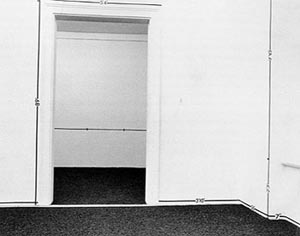 Perhaps the trick is to play 'spot the system'. When afflicted by paralysing doubt as to what accounts for the simultaneous presence of apparently unrelated objects or indeed as to your own place in the world, seize upon a plausible system. The tagline Supported by individual American Patrons and Exhibition Patrons of Tate may provide a facile simulacrum of one. The exigencies of availability of privately collected work produced within the temporal parameters of the exhibition may explain disconcerting omissions (British ones spring to mind: Stephen Willats, John Latham, Mary Kelly ... ) and incongruities of presence (Bas Jan Ader?) as much as anything else. The garrulous kaleidoscope of Open Systems throws up a great deal that is interesting and evocative, as much for the safe detonation of fossilised critical insights as for the infrequency of public display, a form of pleasure gently prompted by the glassy specimens of Marcel Broodthaers' 'Un jardin d'hiver' and the inaudible narration of Robert Smithson's slide projection 'Hotel Palenque' in the adjacent room, but maybe more trenchant in Hans Haacke's 'Shapolsky et al., Manhattan Real Estate Holdings, a Real Time Social System, as of May 1, 1971' installation of photographic panels that were once hot enough to merit the Guggenheim's kibosh, but now smile as serenely from the walls of Tate Modern as a trophy elk over the mantlepiece.
Perhaps the trick is to play 'spot the system'. When afflicted by paralysing doubt as to what accounts for the simultaneous presence of apparently unrelated objects or indeed as to your own place in the world, seize upon a plausible system. The tagline Supported by individual American Patrons and Exhibition Patrons of Tate may provide a facile simulacrum of one. The exigencies of availability of privately collected work produced within the temporal parameters of the exhibition may explain disconcerting omissions (British ones spring to mind: Stephen Willats, John Latham, Mary Kelly ... ) and incongruities of presence (Bas Jan Ader?) as much as anything else. The garrulous kaleidoscope of Open Systems throws up a great deal that is interesting and evocative, as much for the safe detonation of fossilised critical insights as for the infrequency of public display, a form of pleasure gently prompted by the glassy specimens of Marcel Broodthaers' 'Un jardin d'hiver' and the inaudible narration of Robert Smithson's slide projection 'Hotel Palenque' in the adjacent room, but maybe more trenchant in Hans Haacke's 'Shapolsky et al., Manhattan Real Estate Holdings, a Real Time Social System, as of May 1, 1971' installation of photographic panels that were once hot enough to merit the Guggenheim's kibosh, but now smile as serenely from the walls of Tate Modern as a trophy elk over the mantlepiece.
Robert Smithson was of course powerfully interested in systems, or rather, the entropy attendant on them. If the exhibition is to submit to a systemic analysis, it can be read as manifesting this emergent property, entropy, dissolution hot on the heels of homeostasis. On the face of it, this next-to-last phase of perfect homogeneity has been finessed by the show. Work is de-contextualised, the taxonomy and chronology employed can be a touch desultory. Mel Bochner's "Measurement: Room", (black tape and Letraset fixed to the gallery walls, mapping out and indicating their height and length) deliberately telescopes this undecideability between historical gloss and site-fidelity: although the piece was crafted for the installation space in the show, it is not altogether clear whether the measurements of the room in Tate Modern are being taken or the measurements of the original space of installation are being given. The idea is a machine for producing the work, but the mileage of the work is that it does not map cleanly onto the idea - it produces a space of encounter, and contaminates the frame of reference. If the actual measurements of the room in the Tate where this is installed are beside the point, it would be a non sequitur, rendered inoperative as a piece albeit more effective as a museum piece. If the measurements do correspond, then this would be the only moment in the exhibition where space and context emerge, grudgingly, at the unavoidable behest of the work. Either way, the perceptual imbalance prompted by an acme of rigorous precision provides torsion for the navigation of the rest of a staid display and points beyond it. But this is not to eliminate the incipient tokens of entropy. This entropy may make itself felt by small dysfunctionalities accumulating over the course of the exhibition (small objects being filched from interactive displays, projectors going on the blink, Helio Oticia's orange juice machine in his 'Project FILTRO for Vergara, New York' 1972, needing a clean) or in more imposing slippages, like the eschewing of critical context of critique in the presentation of avowedly critical work with specific critical targets. But it may well be the case that the 'Open Systems' proposition can be viewed through yet another prism, one that enjoins us to 'just step sideways' from the whole systems scheme and take a fundamentally unsystematic tack.
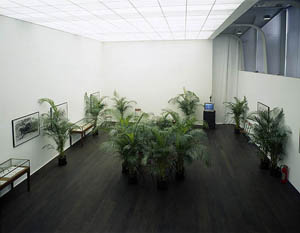 The Wikipedia entry for 'nominalism' tells us that it is the position in metaphysics that there exist no universals outside of the mind. 'Nominalism is best understood in contrast to realism. Philosophical realism holds that when we use descriptive terms such as "green" or "tree" the Forms of those concepts really exist, independently of world in an abstract realm. Such thought is associated with Plato. Nominalism, by contrast, holds that ideas represented by words have no real existence beyond our imaginations.' What valence does the concept hold for Open Systems? Principally, the unflaggingly undead Duchampian insight that art is a function of naming. This would be nominalism in action. If all that artworks have in common is being named as such, this highlights art's status as a particular kind of commodity, rather than a subject of universal judgements of aesthetic taste. Once this is established it ramifies any attempt to reach out into 'non-art' systems, whether parasitically or critically or both. So if the show wants you to play a game of name that system, that's one riposte, which would entail another, folded into the first: look at the naming and the production of difference that ensues. This is difference considered strictly in light of the homeostatic sameness that the 'Open Systems' system produces: this proposition aims to subsume the situated instability of difference and stop it from entropically proliferating. A system opens up to eat; cybernetics should have taught us that much, and Open Systems is no exception, although the exhibition programme at the Tate Modern has served up more striking examples in the past see http://www.tate.org.uk/modern/shrinkingchildhoods/.
The Wikipedia entry for 'nominalism' tells us that it is the position in metaphysics that there exist no universals outside of the mind. 'Nominalism is best understood in contrast to realism. Philosophical realism holds that when we use descriptive terms such as "green" or "tree" the Forms of those concepts really exist, independently of world in an abstract realm. Such thought is associated with Plato. Nominalism, by contrast, holds that ideas represented by words have no real existence beyond our imaginations.' What valence does the concept hold for Open Systems? Principally, the unflaggingly undead Duchampian insight that art is a function of naming. This would be nominalism in action. If all that artworks have in common is being named as such, this highlights art's status as a particular kind of commodity, rather than a subject of universal judgements of aesthetic taste. Once this is established it ramifies any attempt to reach out into 'non-art' systems, whether parasitically or critically or both. So if the show wants you to play a game of name that system, that's one riposte, which would entail another, folded into the first: look at the naming and the production of difference that ensues. This is difference considered strictly in light of the homeostatic sameness that the 'Open Systems' system produces: this proposition aims to subsume the situated instability of difference and stop it from entropically proliferating. A system opens up to eat; cybernetics should have taught us that much, and Open Systems is no exception, although the exhibition programme at the Tate Modern has served up more striking examples in the past see http://www.tate.org.uk/modern/shrinkingchildhoods/.
Meanwhile, the system of art practice and exhibition is constituted by the production of difference, both as a discrete field of endeavour in social space and internally, among its material, de-materialised and discursive objects. So the philosophical impasse between universalism and nominalism repeats itself as a metabolic one, between a system indeterminate in its signification and closed in its effects organising various art work 'systems' attempting to survive and expand by exceeding their membranes and incorporating/infecting other systems, in some cases hoping to trigger extreme systemic breakdown. If a system implies a universal dimension, structuring a multiplicity of relations in enunciating a purpose or set of objectives, nominalism perceives objects as atomised and unities as conventional. Open Systems utilises a bait-and-switch technique, at one moment positing a generality of systemic engagement for its exhibits, at another pulling back and calling this an unverifiable proposition ‚ albeit less in a bracing spirit of inquiry than equivocation. This is one way to enjoy Open Systems or possibly get an intimation of its real modus operandi: first, forget about systems, second, think about systems. The proliferation of names when the flows of signification exceed cognitive and economic rationality, and are in turn encompassed by them, conceptual art has taught us that much. How antagonism turns into an exhibit of congealed time. Think about a power station that was metabolised into the people's palace of cultural enjoyment by the mangle of urban change, think of heat death.
The elision of the disjunctures and correspondences that obtain between the show's thematic and institutional context would make for an easy target. But this hiatus is only an index of an overriding deafness to the vicissitudes of time and site, of life and spectacle and gender and money that conditioned the assembled artefacts, somewhere, sometimes, somehow .. . ? If in Walter Benjamin's words, 'to articulate what is past does not mean to recognize "how it really was" It means to take control of a memory, as it flashes in a moment of danger' we do not run the risk of either the stolid romanticism of the former or the unvetted contingency of the latter in a show pointing out that Donald Judd, who enacted the Minimalist phenomenology of form in space and Cildo Mereiles, who printed oppositional messages on bank notes and Coke bottles and sent them back into circulation, were both engaging with systems.
(There is no doubt a fugitive kink in the system: when I visited the exhibition, the reflection from Martha Rosler's 'Semiotics of the Kitchen' video tape was playing on the glass shielding a large photograph documenting Valie Export and Peter Weibel's 'From the Portfolio of Doggedness' action. Perhaps the seeming abeyance of the curatorial concept was really intended to make space for such quixotic resonances.)
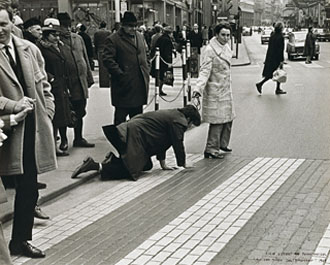 Three days after the show opened, a symposium on curating digital media, Curating, Immateriality, Systems took place as part of the Open Systems events programme. Engrossed in the conundrums of the new curatorial topographies on the table, none of the speakers, save for Danish curator Jakob Lillemose, alluded to the exhibition or the issues it raised at any point, just as the exhibition scrupulously demurred from any address to present-day rethinking of art production or curation. Perhaps inadvertent, or a pleasingly symmetrical illustration of the uses and abuses of the signifier 'open' in what is after all a vertically integrated institution, Tate Modern, capturing funding share through the discursive rehearsal of openness within its walls (see upcoming Open Congress at Tate Britain). Whereas art institutions elsewhere in Europe gamely attempt to restructure themselves in line with the principles of relationality and transience they espouse (Palais D'Tokyo, Rooseum Malmo, Shedhalle Zurich), Tate has never courted such pretensions, diffidently carrying on as a capital-intensive neutral container of big-ticket spectaculars and politicised aesthetic speculation alike. So it is perhaps in the non-convergence of a museum colloquy of experimental culture from 30 and 40 years ago and the quest to adequately museum-ify the 'de-materialised' art of digital networks that the system really comes into its own; a red carpet by the river for 'openness' and a red fire extinguisher for the consequences of the de-materialisation of the art object, even after all this time.
Three days after the show opened, a symposium on curating digital media, Curating, Immateriality, Systems took place as part of the Open Systems events programme. Engrossed in the conundrums of the new curatorial topographies on the table, none of the speakers, save for Danish curator Jakob Lillemose, alluded to the exhibition or the issues it raised at any point, just as the exhibition scrupulously demurred from any address to present-day rethinking of art production or curation. Perhaps inadvertent, or a pleasingly symmetrical illustration of the uses and abuses of the signifier 'open' in what is after all a vertically integrated institution, Tate Modern, capturing funding share through the discursive rehearsal of openness within its walls (see upcoming Open Congress at Tate Britain). Whereas art institutions elsewhere in Europe gamely attempt to restructure themselves in line with the principles of relationality and transience they espouse (Palais D'Tokyo, Rooseum Malmo, Shedhalle Zurich), Tate has never courted such pretensions, diffidently carrying on as a capital-intensive neutral container of big-ticket spectaculars and politicised aesthetic speculation alike. So it is perhaps in the non-convergence of a museum colloquy of experimental culture from 30 and 40 years ago and the quest to adequately museum-ify the 'de-materialised' art of digital networks that the system really comes into its own; a red carpet by the river for 'openness' and a red fire extinguisher for the consequences of the de-materialisation of the art object, even after all this time.
(1) extracted in Conceptual Art: a Critical Anthology, Alexander Alberro and Blake Stimson, eds., MIT Press, 2000.
Mute Books Orders
For Mute Books distribution contact Anagram Books
contact@anagrambooks.com
For online purchases visit anagrambooks.com


